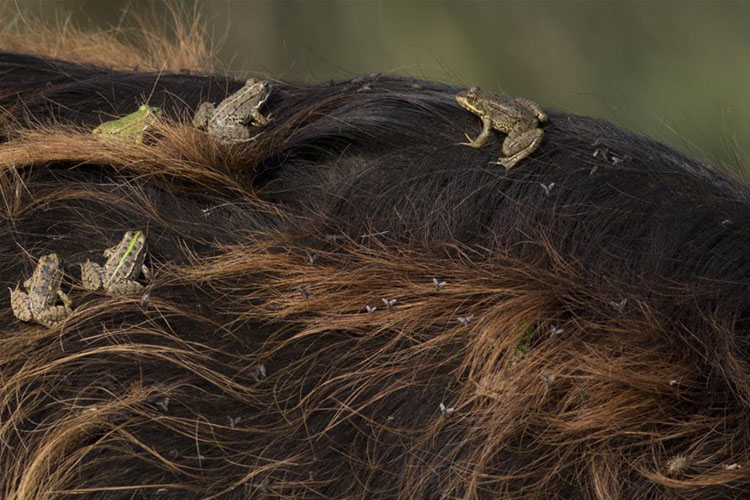Kermit the Frog’s saying, “With good friends, you can’t lose,” appears to apply—rather unusually—to the marsh frog and the Anatolian water buffalo of northern Turkey. A Polish ecologist was bird watching in the Kizilirmak Delta along the Black Sea coast, one of the largest wetlands in the Middle East, when he accidentally happened upon water buffaloes covered with hitchhiking frogs. One water buffalo had 27 frogs clinging to its fur! After this chance discovery, Piotr Zduniak of Poznan‘sAdam Mickiewicz University suspected the animals were more than simple friends, and that their relationship may have biological importance. There are many symbiotic relationships in nature (sharks and pilot fish, for example), but the case of the buffalo and the frog would be the first such mutually beneficial relationship between a mammal and an amphibian. Zduniak, along with two other researchers, carefully studied the buffalo-frog connection, and they found that the phenomenon takes place only in autumn. They explained why in the June 2017 issue of the journal, Acta Herpatologica.
Marsh frogs are not too picky about what they eat, and the species often changes its diet according to what is available. They eat mainly insects, but they sometimes dine on fish, other amphibians, and small mammals. Like many wild beasts, water buffaloes are rife with flies. A slow-moving, marsh-wallowing water buffalo can thus provide frogs with a pleasant sort of dining cruise. And given the choice between being covered in flies or frogs, these buffaloes apparently prefer frogs. More study is needed, however, to prove the buffalo’s preference. Why, for instance, do frogs and buffaloes show this behavior nowhere else? There may be something in the Anatolian marsh water. And why in autumn? Aside from food, the cold-blooded frogs may cling to the warm-bloodedbuffalo for warmth as temperatures cool later in the year.

In nature, a mutualistic relationship occurs when two parties benefit by living in close quarters with each other. For example, certain kinds of ants live in thorny plants. The plants provide food and nesting sites for ants. In return, the ants provide protection from insect pests. The case of the buffalo and the frog is definitely symbiotic, in which one animal always benefits (the frog), and the other animal (the water buffalo) probably also benefits. A similar relationship exists between the small oxpecker bird and large animals of the African plains. The oxpecker perches on such animals as water buffalo (which are a type of wild oxen), antelope, giraffes, rhinoceroses, or zebras. The bird then eats ticksand other small parasites from the animal’s skin and fur.
Image 1: Marsh frogs get cozy on the back of a water buffalo in northern Turkey. Credit: © Nizamettin Yavuz, Firenze University Press
Image 2: Scientists believe marsh frogs cling to water buffaloes for food and warmth. Credit: © Nizamettin Yavuz, Firenze University Press
Untitled Document Can't view the linked articles? Subscribe to World Book Online

World Book Online delivers a progressive sequence of core databases supported by supplemental
tools, such as language translation, graphic organizers, and unique Webquests. Moving from
Early World of Learning to World Book Advanced, World Book Online aligns end-users with their
appropriate learning levels. Each stand-alone site provides additional features to support the
needs of users’ specific capabilities.
The World Book Difference
World Book combines cutting-edge technology with traditional editorial excellence to produce
authoritative, trustworthy, and unbiased content. The digital content is updated in real time and
carefully curated for each learning level. Accessible 24/7, the content is available on a variety of devices.
World Book Online combines 21st-century instructional techniques with timely information.
By breaking down complex topics and using easily understandable text, World Book Online helps to
build fluency and increase comprehension. Featuring single sign-on capability, these sites are paired
with highly visual content to engage even the most reluctant reader. Our collection of resources kindles
a lifelong learning experience for every user. This adherence to clarity, currency, and accuracy makes
World Book’s digital offerings an information hub for the classroom, library, and beyond.